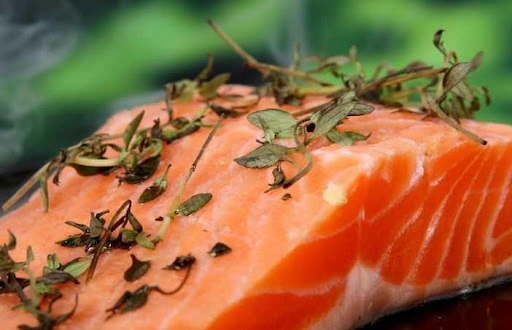Best Ways to Cook Salmon

Salmon is not only a delicious and versatile fish but also a nutritional powerhouse. Packed with omega-3 fatty acids, high-quality protein, and a range of essential nutrients, it’s no wonder that salmon is a favorite among health-conscious individuals. If you’re looking to add this flavorful fish to your diet, you’re in for a treat. In this article, we’ll explore the best ways to cook salmon, ensuring that you make the most of its taste and health benefits.
Why Choose Salmon?
Salmon is a popular choice for many reasons. Its rich, buttery flavor pairs well with a variety of ingredients, making it a versatile addition to your menu. Furthermore, salmon is known for its numerous health benefits, including heart health, brain function, and anti-inflammatory properties due to its high omega-3 content.
Selecting the Perfect Salmon
Before you start cooking, it’s essential to choose the right salmon. Opt for fresh or frozen salmon fillets or steaks. Look for fish with vibrant pink or orange flesh, and ensure it has a fresh, ocean-like scent.
How Do I Know If My Salmon Is Fresh?
You can determine if your salmon is fresh by using your senses and paying attention to specific signs:
Smell: Fresh salmon should have a clean, ocean-like scent. It should not have a strong, fishy or ammonia-like odor. If it smells unpleasant, it may be starting to spoil.
Appearance: Look at the salmon’s appearance:
Color: Salmon can vary in color depending on the species, but it should be vibrant and consistent. For example, wild salmon is typically deeper in color than farmed salmon. Avoid salmon with dull, faded, or uneven coloration.
Texture: The flesh should be moist and firm, not slimy or mushy. Gently press your finger into the salmon; it should bounce back and not leave an indentation.
Gills: If you’re buying a whole salmon, check the gills. They should be bright red, not brown or gray, which is a sign of aging.
Touch: Fresh salmon should feel slightly cool to the touch. If it feels warm or has a sticky texture, it may not be fresh.
Packaging: If you’re buying packaged salmon, check the packaging for any signs of damage or leaks. Ensure the “sell by” or “use by” date is not expired.
Eyes: If you’re buying a whole salmon, examine the eyes. They should be clear and bright, not cloudy.
Flesh Separation: Check the seams between the fillets. If the flesh easily separates or flakes off, it’s a good sign of freshness.
Origin: Knowing where the salmon comes from can also be a clue. Salmon that is sourced locally or from reputable sources is more likely to be fresh.
Ask Questions: If you’re buying salmon from a fishmonger or seafood market, don’t hesitate to ask questions. Inquire about when the salmon was caught or delivered.
Remember that salmon can vary in quality and freshness, so it’s essential to trust your instincts and use these guidelines to make an informed decision. If you have doubts about the freshness of the salmon, it’s best to err on the side of caution and choose a different piece or source.
Basic Preparations for Cooking Salmon
Prepping the Salmon
Begin by rinsing your salmon under cold water and patting it dry with paper towels. Remove any pin bones using tweezers or ask your fishmonger to do it for you. When it comes to mastering the art of salmon preparation, having the right tool is essential. The key to effortless and precise filleting lies in selecting the best fillet knife for salmon.
Seasoning and Marinating
Seasoning and marinating salmon can enhance its flavor. Consider using olive oil, garlic, lemon juice, and herbs like dill or thyme. Let it marinate for at least 30 minutes before cooking.
Popular Cooking Methods
Salmon can be prepared in various ways to suit your taste preferences. Here are some popular methods:
Grilling
Grilling salmon on a cedar plank adds a smoky, earthy flavor. Brush the salmon with marinade and grill for approximately 15-20 minutes.
Baking
Baking salmon is a simple and healthy option. Preheat your oven to 375°F (190°C), place the salmon on a baking sheet, and bake for 12-15 minutes.
Pan-Searing
Pan-searing salmon creates a crispy skin. Heat a pan with olive oil, place the salmon skin-side down, and cook for 4-5 minutes on each side.
Poaching
Poaching salmon in broth or white wine ensures a moist, delicate texture. Simmer the salmon for 10-12 minutes until it flakes easily.
Salmon Cooking Tips and Tricks
Temperature Matters
Salmon is perfectly cooked when its internal temperature reaches 145°F (63°C). Use a food thermometer for accuracy.
Use of Herbs and Spices
Experiment with various herbs and spices to create unique flavor profiles for your salmon dishes.
Doneness Indicators
Check for doneness by gently flaking the fish with a fork. If it easily flakes into large, moist sections, it’s done.
Pairing Salmon with Side Dishes
Enhance your salmon meal with delicious side dishes:
Vegetable Medley
Sautéed or roasted vegetables like asparagus, broccoli, and bell peppers complement salmon’s flavors.
Lemon Butter Sauce
A drizzle of homemade lemon butter sauce adds zesty goodness to your salmon.
Quinoa Salad
A refreshing quinoa salad with cucumber, tomato, and herbs is a light yet satisfying option.
Salmon for Special Occasions
Impress your guests with these special salmon recipes:
Cedar Plank Salmon
Cedar plank salmon is a showstopper at barbecues and gatherings, infusing the fish with a delightful smoky aroma.
Salmon Wellington
For an elegant dinner party, try making salmon Wellington, a savory pastry-wrapped delight.
Healthy Salmon Alternatives
If you’re looking to diversify your seafood choices, consider these alternatives:
Trout
Trout offers a similar taste and nutritional profile to salmon and can be prepared in much the same way.
Mackerel
Mackerel is another omega-3-rich fish that’s both delicious and beneficial for your health.
Salmon Leftovers: Creative Recipes
Don’t let leftovers go to waste. Try these creative recipes:
Salmon Burgers
Transform leftover salmon into flavorful salmon burgers with some spices and breadcrumbs.
Salmon Salad
Make a refreshing salmon salad with mixed greens, cherry tomatoes, and a light vinaigrette.
Sustainability and Sourcing
When buying salmon, consider sustainability and source it responsibly to support healthy oceans and fisheries.
